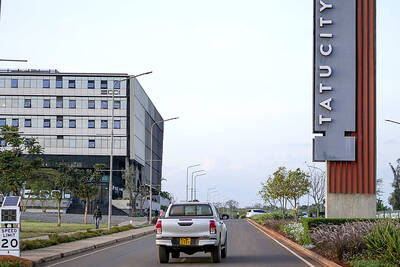Apple Inc has asked its suppliers to produce at least 75 million 5G iPhones for later this year, roughly in line with last year’s launch, in a sign that demand for the company’s most important product is holding up in the midst of the global COVID-19 pandemic and recession.
The Cupertino, California-based technology company anticipates shipments of the next-generation iPhones could reach as many as 80 million units this year, people familiar with the situation said.
Apple next month plans to launch four new models with 5G wireless speeds, a different design and a wider choice of screen sizes, the people said.

Photo: Reuters
Among a comprehensive product refresh, Apple is also preparing a new iPad Air with an edge-to-edge iPad Pro-like screen, two new Apple Watch versions and its first over-ear headphones outside the Beats brand, they said, adding that a smaller HomePod speaker is also in the works.
An Apple spokeswoman declined to comment.
Apple and its manufacturing partners always ramp up production ahead of the rollout of new iPhones each fall. In the summer of last year, suppliers were preparing to make components for as many as 75 million handsets. The target in 2018 was similar, so this year’s goal of 75 million to 80 million units is a bullish sign.
While the COVID-19 pandemic has hammered the global economy and disrupted supply chains, Apple is seeing strong demand for iPhones, iPads and Mac computers from people working and studying remotely.
Revenue from iPhones crushed Wall Street expectations in the second quarter. The device still generates almost half of Apple’s sales and that often tops 60 percent in the holiday season.
The four new iPhones are to be split into two basic and two high-end models for the first time, and all are to feature OLED displays with improved color and clarity.
The two regular iPhones are to come in a new 5.4-inch size and a 6.1-inch option, while the Pro devices are to offer a choice of a 6.1-inch or an enlarged 6.7-inch display, which would be the largest Apple’s ever put in an iPhone.
All of the new smartphones are to have updated designs with squared edges similar to the iPad Pro, while the high-end phones would continue to use stainless steel edges versus aluminum sides on the cheaper variants.
Apple is also planning a dark blue color option on the Pro models to replace the midnight green of last year’s iPhone 11 Pro.
Apple plans to ship the lower-end phones sooner than the Pro devices, people familiar with the staggered release strategy said.
In a conference call, Apple said that the new iPhones would ship a “few weeks” later than last year’s models, which started shipping on Sept. 20.
This year’s rollout is on course to be the latest since the release of the iPhone X in November 2017.

To many, Tatu City on the outskirts of Nairobi looks like a success. The first city entirely built by a private company to be operational in east Africa, with about 25,000 people living and working there, it accounts for about two-thirds of all foreign investment in Kenya. Its low-tax status has attracted more than 100 businesses including Heineken, coffee brand Dormans, and the biggest call-center and cold-chain transport firms in the region. However, to some local politicians, Tatu City has looked more like a target for extortion. A parade of governors have demanded land worth millions of dollars in exchange

Hong Kong authorities ramped up sales of the local dollar as the greenback’s slide threatened the foreign-exchange peg. The Hong Kong Monetary Authority (HKMA) sold a record HK$60.5 billion (US$7.8 billion) of the city’s currency, according to an alert sent on its Bloomberg page yesterday in Asia, after it tested the upper end of its trading band. That added to the HK$56.1 billion of sales versus the greenback since Friday. The rapid intervention signals efforts from the city’s authorities to limit the local currency’s moves within its HK$7.75 to HK$7.85 per US dollar trading band. Heavy sales of the local dollar by

Taiwan Semiconductor Manufacturing Co’s (TSMC, 台積電) revenue jumped 48 percent last month, underscoring how electronics firms scrambled to acquire essential components before global tariffs took effect. The main chipmaker for Apple Inc and Nvidia Corp reported monthly sales of NT$349.6 billion (US$11.6 billion). That compares with the average analysts’ estimate for a 38 percent rise in second-quarter revenue. US President Donald Trump’s trade war is prompting economists to retool GDP forecasts worldwide, casting doubt over the outlook for everything from iPhone demand to computing and datacenter construction. However, TSMC — a barometer for global tech spending given its central role in the

The Financial Supervisory Commission (FSC) yesterday met with some of the nation’s largest insurance companies as a skyrocketing New Taiwan dollar piles pressure on their hundreds of billions of dollars in US bond investments. The commission has asked some life insurance firms, among the biggest Asian holders of US debt, to discuss how the rapidly strengthening NT dollar has impacted their operations, people familiar with the matter said. The meeting took place as the NT dollar jumped as much as 5 percent yesterday, its biggest intraday gain in more than three decades. The local currency surged as exporters rushed to